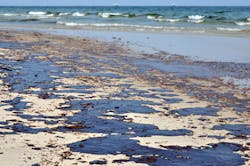New sponge could help clean up contaminated water sources
WEST LAFAYETTE, Ind. — April 4, 2016 — Researchers at Purdue University developed new environmental cleanup technology for continuously removing oils and other pollutants from water.
A study published in the American Chemical Society‘s journal Industrial & Engineering Chemistry Research shows that the new sponge product is superhydrophobic and superoleophilic, which means that it rejects water while absorbing oils.
It is made using commercially available materials, including melamine sponge, an ultra-low-weight, porous material found in various products including household cleaning pads and insulation materials. The researchers modified the melamine sponge by dipping it into a solution containing a small amount of silicone rubber called PDMS and the solvent hexane, resulting in an extremely thin coating that repels water while allowing oil to be absorbed into the sponge.
“The reason we’re excited about this is that it is manufactured using a very inexpensive one-step process to coat the melamine sponges, and the material can be reused many times,” commented Suresh V. Garimella, Purdue University’s executive vice president for research and partnerships and the Goodson Distinguished Professor of Mechanical Engineering. “We believe this can be readily adopted for the cleanup of oil spills and industrial chemical leaks.”
Tests conducted by the researchers demonstrated that the new material can remove oils and organic chemical pollutants that are immiscible (incapable of being mixed or blended together) with water such as hydrocarbons, coolants and insulating fluid from electrical transformers, carcinogenic compounds called PCBs and certain pesticides.
“Oil spillage from industrial sources has caused severe damage to the environment,” said postdoctoral research associate Xuemei Chen. “The conventional methods used to clean up oils and organic pollutants are slow and energy-intensive. The development of absorbent materials with high selectivity for oils is of great ecological importance for removing pollutants from contaminated water sources.”
The sponge material has an absorption capacity of 45 to 75 times its own weight, which is comparable to other, “more exotic” materials under development, Purdue University said.
“There are two ways to use this sponge,” Garimella explained. “You can just drag it over the surface of the water to absorb the contaminant or apply suction so that it continuously draws out the oil and leaves the water behind.”
The researchers have filed a provisional U.S. patent application for their discovery.
